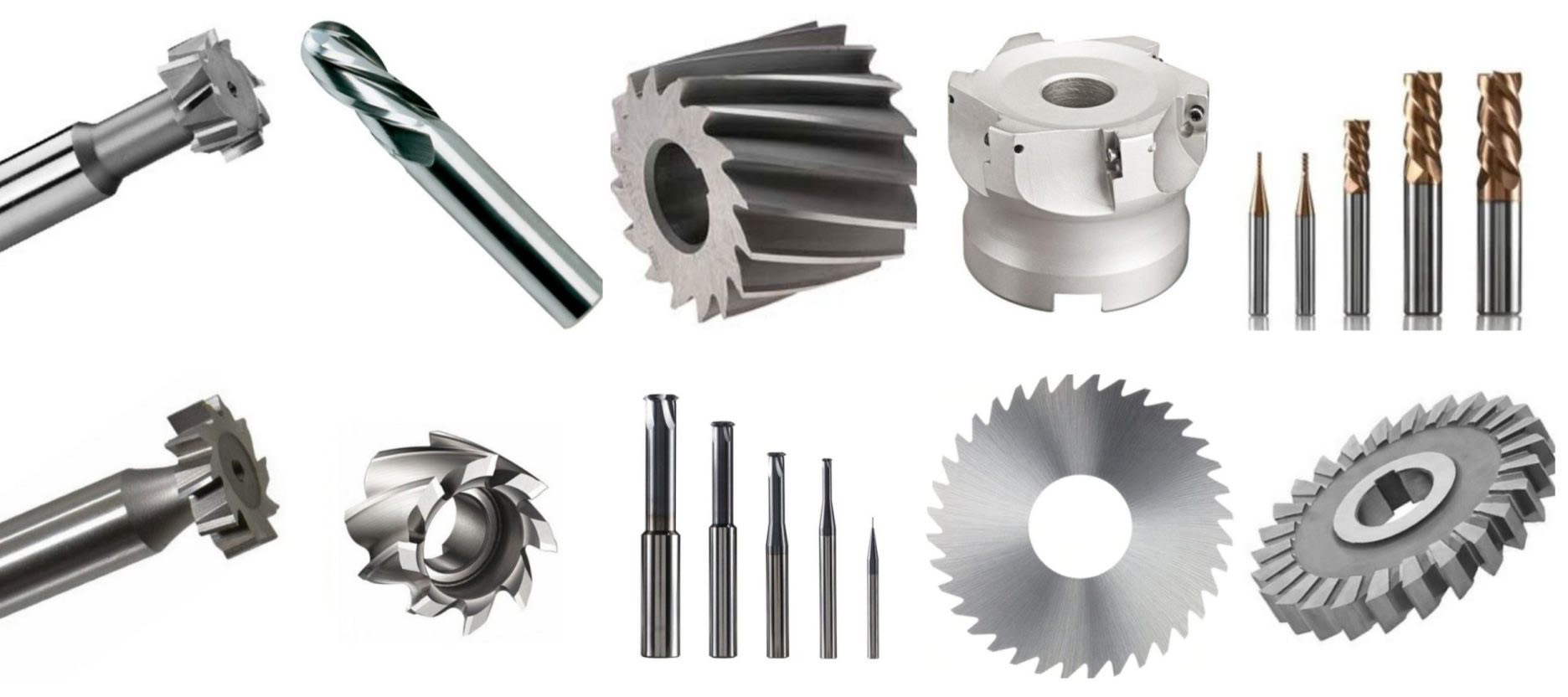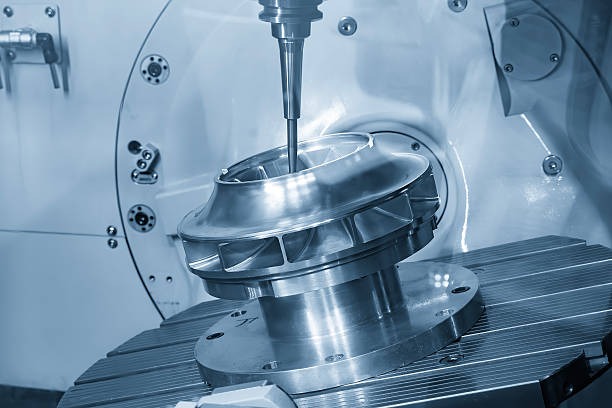フライスカッター 工具は多くの工房や工場の主力製品です。金属、プラスチック、その他の素材を迅速かつ正確に成形するのに役立ちます。複雑な部品を作る場合でも、単純な切断を行う場合でも、これらの工具は効率的に作業を完了させます。
フライスカッターには様々な種類があり、それぞれ特定の作業向けに設計されています。粗い形状を素早く削り出すものもあれば、表面を完璧に滑らかに仕上げることに特化したものもあります。適切なフライスカッターを選ぶことで、作業が楽になり、仕上がりもきれいになります。
現代のカッターは、高度な素材とスマートな設計を採用することで、耐久性と切削性能を向上させています。適切な選び方と使い方を理解すれば、加工を次のレベルに引き上げることができます。
フライス盤は、様々な加工作業に対応するために、それぞれ異なる設計になっています。それぞれのタイプは、特定の切削や材料の種類に最適な性能を発揮するように調整されています。違いを理解することで、プロジェクトに最適な工具を選ぶことができます。
工具を選ぶ際には、作業効率、表面仕上げ、そして工具の寿命などを考慮して決める必要があります。今回は、作業場で使える可能性のある5種類のフライスカッターをご紹介します。

エンドミルに勝るものはありません。多方向に切削できるため、溝、ポケット、複雑な形状の加工が可能です。鋼、アルミニウム、プラスチックの加工には、エンドミルが最適です。刃先が溝状になっているため、切りくずの排出が容易で、工具の冷却効果を高め、摩耗を軽減します。
大きな平面部を高速かつ滑らかに切削するのに優れています。工具の刃先には多数のインサートが配置されているため、材料を素早く容易に切削できます。平面を作ったり、大きなパネルを研磨したりしたい場合は、フェイスミルが最適です。
広い面の切断には、多くの場合、スラブミルが使用されます。スラブミルは、困難なプロジェクトにも対応できるよう設計されています。スラブミルは、その強度と大口径により、厚い材料を高速で切断できるように設計されています。スラブミルは、鋼板の初期成形など、大量の材料を迅速に切断する必要がある場合に不可欠です。
ボールノーズカッターは平らな先端ではなく丸い先端部を備えているため、3D形状の造形や彫刻に最適です。滑らかな曲線を描くため、金型製作やダイ加工にも役立ちます。製造が難しい部品に目立つ跡が残らないように設計されています。
ねじ切りフライス盤は、様々な材料に内ねじまたは外ねじを加工するために設計されています。ねじ切りフライス盤を使用すると、目的のねじの状態を正確に管理・監視できます。機械の送り深さと速度を変えることで、同じ工具でねじのサイズを変更できるため、柔軟性に優れています。
加工を成功させるには、適切なフライスカッターを選ぶ必要があります。最良かつ最も正確な結果を得るためには、重要なポイントを検討する必要があります。適切な選択を行うことで、時間とコストを節約し、工具の寿命を延ばすことができます。
加工対象によってカッターの選択は異なります。ステンレス鋼は強度が高いため、耐久性を確保するには超硬カッターが必要です。アルミニウムやプラスチックの場合は、HSSカッターが適しています。適切なカッター材質を使用することで、必要になる前に摩耗を防ぎ、ワークの仕上がりを良好に保つことができます。
ナイフのカッターの形状と刃のデザインは、切削方法を変える可能性があります。刃の数が多いほど表面仕上げは良くなりますが、切削片を除去できるスペースが制限されます。切削片の流れと切削工具に作用する力は、ねじれ角によって異なります。柔らかい材料には大きなねじれ角が必要であり、硬い金属には小さなねじれ角の方が適しています。
加工工程で何を達成したいかによって、カッターの選択は大きく左右されます。荒削り用カッターは加工速度は速いですが、仕上がりの見栄えは劣ります。木材の滑らかで繊細な部分は仕上げ用カッターで仕上げます。あらゆる切削作業に適切なカッターを選択することで、工具の破損を防ぎ、より高品質な製品を生み出すことができます。
カッターは必ずしもすべての 機械の種類保持システムの設計と主軸回転速度によって、使用するカッターが決まります。工具を正しく配置することで、振動、振れ、摩耗を軽減できます。カッターを購入する前に、機械の仕様をご確認ください。
最新のコーティングは、カッターの耐久性と切削性能の両方を向上させます。窒化チタン(TiN)または窒化アルミニウムチタン(AlTiN)のコーティングを施すことで、熱と摩擦が軽減されます。高速加工や高圧力加工では、コーティングされたカッターが最も長持ちします。
フライスカッターは様々な業界で使用されています。木工プロジェクトの仕上げをスピードアップし、作業効率を向上させます。このセクションでは、フライスカッターの最も一般的な使用方法をいくつかご紹介します。
フライス加工において、チタンなどの金属部品の成形はカッターに依頼されることが多く、正確で安全な部品の設計が求められます。これらのカッターによって、航空機部品は優れた成形性と耐久性を実現しています。
自動車メーカーでは、エンジン、ギアボックス、フレームの加工にフライス加工用のハンドツールを使用しています。これらの工具を使用することで、材料を素早く成形でき、部品の精度が常に保たれます。この方法は、車両の性能を向上させ、組み立て時の誤差を低減します。
今日、金型メーカーはボールノーズカッターと呼ばれる高度なカッターを使用しています。これらの工具でレリーフを形成し、表面を滑らかに仕上げることがよくあります。強力なフライス加工により、プラスチックや金属の金型製作の効率が向上します。
フライスカッターは、小型電子機器や機械など、様々な製品の製造を可能にします。基本的な設計から詳細な設計まで、あらゆる用途に対応します。これにより、製造は迅速かつ柔軟に行えるようになりました。
フライスカッターは、修理工場で摩耗した部品の交換や修理に使用されます。表面を平らにしたり、損傷箇所の不具合を修復したりすることができます。高価な工具や機械の寿命を延ばすのに役立ちます。
フライスカッターの使用には、いくつかの一般的な課題が伴います。これらを理解することで、問題を回避し、より良い結果を得ることができます。ここでは、フライス加工時に直面する可能性のある一般的な問題をいくつかご紹介します。
フライスカッターは、硬い材料を切削することで時間の経過とともに摩耗します。摩耗したカッターは切れ味が悪くなり、突然破損することもあります。適切な種類のカッターを使用し、工具を鋭利に保つことで、この問題を回避できます。
切削は熱を発生し、カッターと材料の両方に損傷を与える可能性があります。適切な切りくず除去を行うことで、切りくずが切削を妨げ、過熱を引き起こすのを防ぎます。適切なフルート設計のカッターを選択し、クーラントを使用することで、材料を冷却することができます。
振動(チャタリングとも呼ばれます)は、表面を粗くし、工具を損傷する可能性があります。工具がしっかりと保持されていない、または速度が適切でない場合に発生します。強力なカッターを使用し、適切な速度を設定することで、振動を軽減できます。
カッターの切れ味が鈍かったり、速度が速すぎたり遅すぎたりすると、表面が荒れたり、凹凸ができたりします。適切なカッターを使用し、カット設定を調整することで、滑らかな仕上がりになります。
すべてのカッターがすべての機械に適合するわけではありません。サイズや種類を間違えると、工具のぐらつきや損傷などの問題が発生する可能性があります。必ず、カッターが機械の要件を満たしていることを確認してください。
良い結果とコスト削減をお望みなら、以下の簡単な手順をお試しください。フライスカッターの性能が向上し、寿命が延びます。
作業対象に適したカッターを選びましょう。超硬カッターは硬い金属の加工に適しています。ガラスは高速度鋼カッターで良好に切断できます。コーティングされたカッターは熱と摩耗が抑えられるため、寿命が長くなります。
速すぎる、あるいは速すぎると問題が生じる可能性があります。使用する材料と工具に適した切断速度と速度をテストしてください。そうすることで、作業はきれいに仕上がり、工具も安全になります。
カッターが機械にしっかりと固定されていることを確認してください。工具がしっかりと固定されていないと、切断面が不安定になったり、作業中に振動が発生したりする可能性があります。工具ホルダーの交換時期については、取扱説明書をご覧ください。
カッターはクーラントによって冷却され、切りくずは排出されます。切れ味を保てば、表面は均一になります。作業時には適切なクーラントをお選びください。
カッターに損傷がないか確認してください。破損したり、性能が低下したりしたら使用しないでください。定期的に適切な点検を行うことで、待ち時間と費用を削減できます。

フライスカッターの鋭い切れ味と効率性を維持するには、適切なメンテナンスが不可欠です。工具を丁寧に手入れすることで、寿命が延びるだけでなく、作業の質も向上します。ここでは、フライスカッターを効果的にメンテナンスするための重要な手順をご紹介します。
清掃することで、残った切削片や切削液を取り除くことができます。錆や汚れの蓄積を防ぐのに役立ちます。カッターの刃は、柔らかいブラシか布で拭いてください。刃先を弱める可能性のある化学薬品は使用しないでください。カッターを清掃することで、鋭い切れ味を保ち、常に良好な状態を保つことができます。
カッターは水や鋭利なものに触れない場所に保管してください。工具同士がぶつからないように、ケースやラックに保管してください。適切な処置をせずにカッターを積み重ねないでください。工具を適切に保管することで、刃の錆を防ぎ、工具を長く使い続けることができます。
必ず探してください 欠け、鈍いエッジ、またはひび割れ カッターの摩耗にご注意ください。摩耗したカッターは部品を損傷する可能性があります。問題が発生する前に新しいカッターをご購入ください。摩耗を早期に発見することで、時間と費用の両方を節約できます。
機械の推奨速度と送り速度に従うことは非常に重要です。適切な速度に設定されていないと、部品が熱くなりすぎて摩耗してしまう可能性があります。機械の動作が遅すぎると、カッターが損傷しやすくなります。最良の結果を得るには、メーカーの推奨に従って製品を使用するようにしてください。
クーラントは機械の熱を逃がし、切削片を洗い流すために使用します。クーラントを使用することで、カッターの切れ味が長持ちします。切削対象物と切削工具に合わせてクーラントを選択してください。潤滑は工具だけでなく、作業対象物の安全性も確保します。
フライスカッターは現代の製造業に不可欠な工具です。適切なカッターを選択し、適切にメンテナンスすることで、時間とコストを節約できます。よくある課題を理解することで、コストのかかるミスを回避できます。ベストプラクティスに従うことで、工具寿命を延ばし、より良い加工結果を得ることができます。
航空宇宙、自動車、あるいは一般的な製造業など、どのような業界でも、フライスカッターは高精度で高品質な部品を効率的に製造するのに役立ちます。工具を清潔に保ち、鋭利な状態に保ち、正しく使用することで、安定した性能が確保され、ダウンタイムが短縮されます。
Q1. フライスカッターは通常どのような材料で作られていますか?
フライスカッターは、一般的に高速度鋼(HSS)、超硬合金、コバルト合金で作られています。超硬合金は硬い材料に適しており、HSSは柔らかい金属に適しています。
Q2. 材料に適したフライスカッターを選択するにはどうすればよいですか?
ワークの硬度とカッター材質を考慮してください。硬い金属には超硬カッター、柔らかい金属にはHSSカッターを使用してください。また、加工の種類に合わせてカッターの形状も選定してください。
Q3. フライスカッターの摩耗の原因は何ですか、またそれを最小限に抑えるにはどうすればよいですか?
摩耗は摩擦、熱、そして切削片の除去不良によって引き起こされます。適切な速度、送り、クーラントを使用し、工具を清潔に保つことで摩耗を軽減し、カッターの寿命を延ばすことができます。
Q4. フライスカッターとツールホルダーの互換性はどの程度重要ですか?
非常に重要です。適切なフィットは振動や工具の振れを防ぎ、精度を向上させ、カッターの早期故障を防ぎます。
Q5. フライスカッターはいつ交換すればよいですか?
刃先が鈍くなったり、欠けたり、表面仕上げが劣化したりした場合は、カッターを交換してください。早めに交換することで、切断不良や部品の損傷を防ぐことができます。